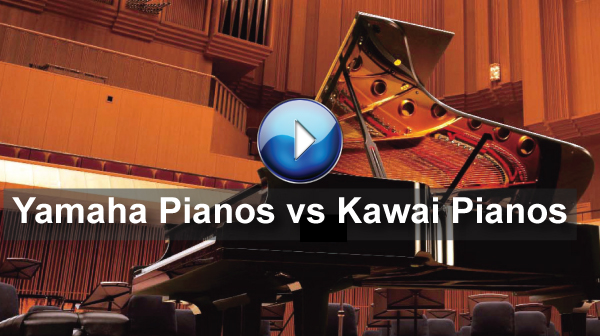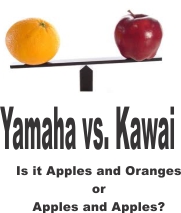
|
Everyone knows the name Yamaha. We see their name on boats, engines, snowmobiles, audio equipment and other products. It is well recognized and it is just about everywhere. You might even own a Yamaha product. As a huge international company they are known for maintaining high quality standards for all their products- including their pianos.
The Tone Consideration
Let’s be honest, tone is subjective. When comparing the sound of the two pianos, people typically find the sound of the Yamaha a shade richer than the Kawai. Yamaha tends to voice there pianos with more brightness. But a piano is an individual purchase, and you may not know which your prefer until you actually listen to them. Quality products from competing manufacturers should always be compared by playing or listening.
Playing and listening should determine which piano is the one for you. The Technology Consideration
Yamaha takes a proven traditional approach to their actions combining modern construction techniques with more traditional materials.
Kawai
uses plastic parts in their piano actions. Both pianos have become renowned for the responsiveness and evenness of their piano actions, regardless of the design criteria and materials used. Again, you should compare the difference in touch. Yamaha has raised the bar in piano technology by actually using technology to improve the function and use for the pianist. They are changing the "interface", much like Windows and Mac changed the text world of computers to graphics. For example all Yamaha traditional acoustics are available with an exclusive Silent Feature that allows for silently playing an acoustic piano while using headphones.
Yamaha also offers series of Hybrid pianos, that effectively blend the real action of acoustic pianos with the versatility of the worlds finest digital piano features. Yamaha also offers I-pad and I-phone controls, wireless connections to thousands of music titles ( digital sheet music) and recording functions. And all available on both digital pianos and traditional acoustic pianos. Check out the apps.
It is true that Yamaha is usually perceived the "leader" if simply by name recognition. While it is also generally accepted that both companies offer world class pianos, the retail prices for comparable pianos generally show that they are comparably priced. Because of the exclusive new Yamaha "interfaces", Yamaha generally has a wider selection of models available and have a high resale value.
The Final Consideration
It's important to recognize that these two Japanese piano manufacturers are both building pianos of the highest quality, and have been doing so for many years. In fact in the beginning founders of these piano giants were actually working side by side to build reed organs in 1887. And both companies now build pianos in countries other than Japan. So before you purchase your next piano, we advise that you play and compare similar models of pianos before making your final decision on which piano is best for your family. And be sure to have your piano dealer show you how your new piano will connect to the exciting world of technology that takes pianos to a new level.
Be sure to explorer the rest of our website where you will be able to find more information about all types of pianos, keyboards and other musical instruments. |




.jpg)